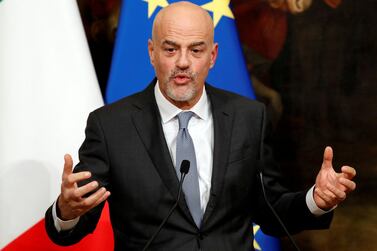A new crop of US Congresspeople is sowing the seeds for a Green New Deal, an ambitious and still amorphous plan to reshape the economy, employment and society in service of the environment. On Friday, thousands of British schoolchildren took the day off to protest for action against climate change.
As the political momentum on the environment shifts, is it time for a green new deal in the UAE, too?
The American Green New Deal is defined differently by its various stakeholders and proponents. It is inspired by president Franklin D Roosevelt’s Depression-era “New Deal”, an evolving package of public works, social assistance and financial regulation.
Its 21st century incarnation moves to a low-carbon economy by investing in renewable energy, electric vehicles, and public transport, energy efficiency. It would build climate resilience by measures such as constructing coastal defences and upgrading buildings. Countering worries about globalisation, Chinese competition and workplace robots, the plan is intended to create jobs, via spending on infrastructure and through developing new “green” industries and technologies.
A US Green Deal faces fierce political debate and opposition. By contrast, a UAE Green Deal would build on existing plans, notably 2012’s Green Growth strategy, and 2017’s Energy Strategy 2050.
Such a programme would have three objectives. The first is to deliver a clean domestic economy that meets and goes well beyond the Paris goals for reducing greenhouse gases. To keep global warming to no more than 1.5°C, already an ambitious goal, net world emissions have to reach zero by 2050, and preferably by 2035. As a wealthy, albeit developing, country, the UAE alignment with that is important.
Eliminating carbon dioxide from electricity generation would be the first and easiest, though still very large task – moving to solar, nuclear, and gas and coal solely with carbon capture and storage (CCS). Vehicles would be electric, and public transport – metros, rail, perhaps self-driving taxis and the Hyperloop – greatly expanded. Air and sea travel would run on batteries or hydrogen. Industry too – steel, aluminium, petrochemicals, cement, ceramics - would be electrified or use CCS. Green construction would have a low carbon footprint, while a circular economy would emphasise recycling and reuse of materials.
The second goal is to make the country resilient to inevitable climate change: even higher summer temperatures, rising sea-levels and perhaps more damaging storms. Buildings need to be better-insulated and capable of self-cooling, cities more walkable and cyclable. Sheltered walkways, greenery, reflective surfaces, integrated public transport, and proper support from telecoms companies for remote working, help cope with hot summers.
In a volatile region, with large regional neighbours vulnerable to drought, floods, pandemics and political instability, skilled diplomacy and focused aid is essential.
The third aim is to create new industries that can supplement and eventually replace the hydrocarbon business as the motor of the national economy. These must be oriented towards high-technology exports, making use of unique national advantages.
Promising areas include CCS, using captured carbon dioxide to extract oil or to form useful materials. As well as capture from power plants and industry, direct extraction of carbon dioxide from the air is essential to reverse past decades of excess emissions.
Hydrogen could be another pillar of the future energy economy alongside electricity, used as a chemical feedstock, a fuel for ships and planes, and a store for temporary surpluses of energy. It can be produced from natural gas with CCS, or using abundant renewables to electrolyse water. CCS and hydrogen could each become export-focused industries larger than the current oil and gas sector.
As the world’s leading region for desalination, the GCC needs renewable drinking and agricultural water, and a way to use or dispose safely of the highly saline brine leftover. The Masdar Institute has researched farming, including growing biofuels, using saline water.
Also important is adapting existing technologies, such as batteries and solar power, to operate well in high ambient temperatures. And the UAE’s programmes for space and for rain-making by cloud seeding might hold promise for the emerging area of geo-engineering – cooling the planet with particles in the upper atmosphere or mirrors in orbit.
Such a plan faces two outstanding challenges. Clean-tech manufacturing is highly competitive, featuring low-cost Chinese suppliers and highly-efficient, sophisticated automated ones in countries such as Japan and Germany. Other countries, notably the US, generate value from technology development, design and branding, based on clusters of world-class universities and venture capitalists.
The UAE could be a hub for regional new energy. But neighbours, notably the key market of Saudi Arabia, have their own plans to demand high levels of local content in renewable projects. The country cannot cover all the green bases, but it can research and invest in those that align best with its unique circumstances. And it can seek to work cooperatively on cross-border electricity, carbon dioxide or other projects with neighbours such as Saudi Arabia and Oman.
The second challenge is for the government to lead while unleashing the capabilities of the private sector, domestic and foreign. Giant local state companies are the natural leaders of many green megaprojects, such as the Baraka nuclear power plant, the Mohammed bin Rashid solar park or the Dubai metro. But there is a danger they can obstruct progress elsewhere through conservatism.
Essential tools include support for basic research and for early-stage deployment of promising technologies, attracting world-class green minds and companies, turning banks from obstacles to enablers, enforcing bold standards for energy use and greenhouse gas emissions, and making government and corporate leaders accountable for delivering the green economy.
The state has to water the desert, so the green shoots of innovation and entrepreneurship can blossom.
Robin M. Mills is CEO of Qamar Energy, and author of The Myth of the Oil Crisis







